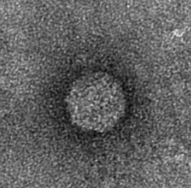Team:Wageningen UR/InsideModification
From 2012.igem.org
| Line 27: | Line 27: | ||
Constructing a CCMV VLP with a negative charge was facilitated by 4 subsequent PCR steps. Luckily, this construct was finished in august and we were able to place an IPTG promoter combined with an RBS site in front of it. The next step was to produce VLPs with this new construct, which succeeded. As a proof of concept, the CCMV VLPs with a negative interior were loaded with iron ions and monitored using electron microscopy. | Constructing a CCMV VLP with a negative charge was facilitated by 4 subsequent PCR steps. Luckily, this construct was finished in august and we were able to place an IPTG promoter combined with an RBS site in front of it. The next step was to produce VLPs with this new construct, which succeeded. As a proof of concept, the CCMV VLPs with a negative interior were loaded with iron ions and monitored using electron microscopy. | ||
| - | [[File:CCMV_NEG_VLP.png|200px|thumb|left| | + | [[File:CCMV_NEG_VLP.png|200px|thumb|left|A CCMV VLP with negative interior]] |
| + | |||
| + | |||
| + | |||
Revision as of 15:20, 20 September 2012
Contents |
Inside Modifications
Introduction
Since virus-like particles (VLPs) lack genetic content, they enclose an empty space. This space can be filled with proteins such as antibiotics, hormones, and all sorts of farmaceuticals. Modifications on the inside of the VLPs can increase binding affinity to the loaded substance. One of the modifications we pursue is adding a coil to the protein subunits at any location that is exposed on the inside of the VLP. In our case, this is a fusion to either the N-terminal or the C-terminal. The coils will facilitate strong attachment to the substance which carries the opposite coil.
Another way to open up more options for loading our VLPs, is to make a change in the interior's charge. Normally, the interior of a VLP is positively charged, facilitating interaction with negatively charged DNA/RNA molecules. By changing the amino acid sequence that is located on the interior of a VLP, the positive charge can be changed into a negative charge. A VLP with a negatively charged interior can be loaded with all sorts of positively charged molecules, such as polymeres, metals, etc.
First Aim: Construct a Virus-Like Particle that has coils exposed on the inside.
Second Aim: Construct a Virus-Like Particle that has a negatively charged interior.
CCMV
The Cow Chlorotic Mottle Virus (CCMV) VLP is one of the best candidates for drug delivery, since it is tolerant of high temperatures and stable in a wide pH range. Next to that, the wild-type CCMV VLP is not specific for mammalian cells in vivo. Because the CCMv VLP is such a good candidate, we decided to place coils on the interior. Since the N-terminus of the CCMV VLP subunits is folded to the inside, this was the logic place to attach the coil to.
To get the most out of the CCMV VLP, the interior was given a negative charge. While the wild-type CCMV VLP can not be loaded with positively charged substances, this modified version can. This
Results:
Attachment of a coil to the N-terminus of the CCMV VLP subunits was carried out in 4 subsequent PCR steps. Unluckily, the primer of the first step was not designed correctly, resulting in a frameshift over the entire VLP, making this construct useless. We discovered this on the 18th of Septembre, when receiving our sequencing results.
Constructing a CCMV VLP with a negative charge was facilitated by 4 subsequent PCR steps. Luckily, this construct was finished in august and we were able to place an IPTG promoter combined with an RBS site in front of it. The next step was to produce VLPs with this new construct, which succeeded. As a proof of concept, the CCMV VLPs with a negative interior were loaded with iron ions and monitored using electron microscopy.
Hepatitis B
Results:
 "
"










